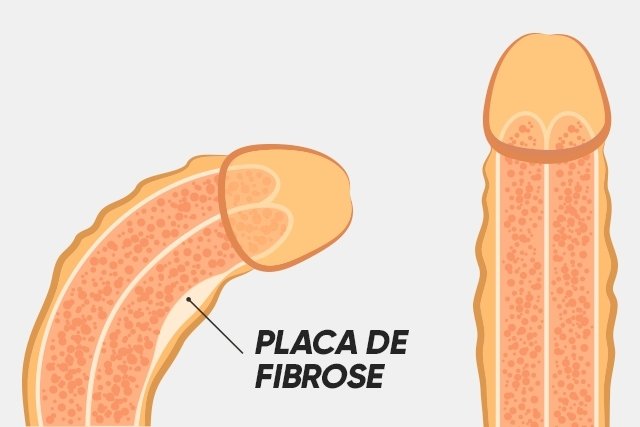Peyronie’s disease is a change in the penis caused by the appearance of rigid fibrosis plaques in the corpora cavernosa, causing an abnormal curvature of the penis to develop, which makes erection and intimate contact difficult.
This condition appears throughout life and should not be confused with congenital curved penis, which is present at birth and is generally diagnosed during adolescence. Therefore, for the disease to be confirmed, it is important that the urologist is consulted so that physical and/or imaging examinations can be carried out to confirm the diagnosis and, thus, the most appropriate treatment can be initiated.

Main symptoms
The most common symptoms of Peyronie’s disease include:
- Abnormal curvature of the penis during erection;
- Presence of a lump on the body of the penis;
- Pain during erection;
- Difficulty in penetration.
Some men may also experience depressive symptoms, such as sadness, irritability and lack of sexual desire, as a result of changes in their sexual organ.
The diagnosis of Peyronie’s disease is made by a urologist through palpation and observation of the sexual organ and ultrasound to check for the presence of fibrotic plaque.
What causes Peyronie’s disease
There is still no specific cause for Peyronie’s disease, however it is possible that small traumas during sexual intercourse or during sports, which lead to the appearance of an inflammatory process in the penis, can cause the formation of fibrosis plaques.
How the treatment is carried out
Treatment for Peyronie’s disease must be guided by the urologist according to the signs and symptoms presented by the man, curvature of the penis and stage of the disease.
In the acute phase of the disease, which corresponds to the initial period in which there are inflammatory symptoms but there is no fibrosis and scarring yet, the doctor may only recommend the use of anti-inflammatory medicines to help alleviate the symptoms.
However, when Peyronie’s disease is already in the more chronic phase, in which fibrosis and scarring and a large curvature of the penis can be observed, the doctor usually recommends surgery to remove the fibrosis and correct the curvature, especially when there is difficulty of penetration.
However, surgery for Peyronie’s disease may be related to some complications, such as penis shortening, erectile dysfunction and decreased sensitivity. Therefore, it is important to discuss the treatment possibilities for Peyronie’s disease with your urologist before surgery is performed.
Bibliography
- UROLOGY PORTAL. Peyronie’s Disease: Diagnosis and Clinical Treatment. 2015. Available at: <https://portaldaurologia.org.br/medicos/wp-content/uploads/2015/09/doenca_de_peyronie_diagnostico_e_tratamento_clinico.pdf>. Accessed on April 14, 2021
- UROLOGY – STATE UNIVERSITY OF RIO DE JANEIRO. Peyronie’s disease. Available at: <https://www.urologiauerj.com.br/livro-uro/capitulo-29.pdf>. Accessed on April 14, 2021
- BRAZILIAN SOCIETY OF UROLOGY. Find out what Peyronie’s disease is and how to treat it. Available at: <https://sbu-sp.org.br/publico/saiba-o-que-ea-doenca-de-peyronie-e-como-tratar/>. Accessed on April 14, 2021

Sign up for our newsletter and stay up to date with exclusive news
that can transform your routine!
Warning: Undefined array key "title" in /home/storelat/public_html/wp-content/plugins/link-whisper-premium/templates/frontend/related-posts.php on line 12
Warning: Undefined array key "title_tag" in /home/storelat/public_html/wp-content/plugins/link-whisper-premium/templates/frontend/related-posts.php on line 13




